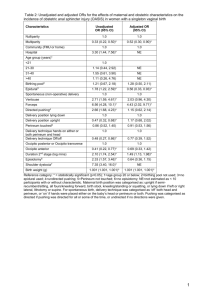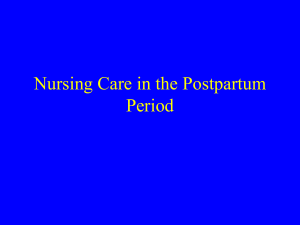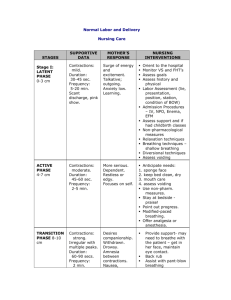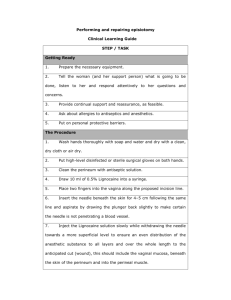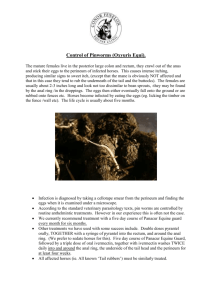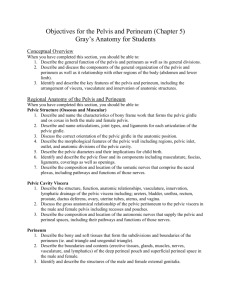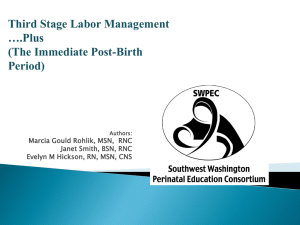20140418045327_8450
advertisement
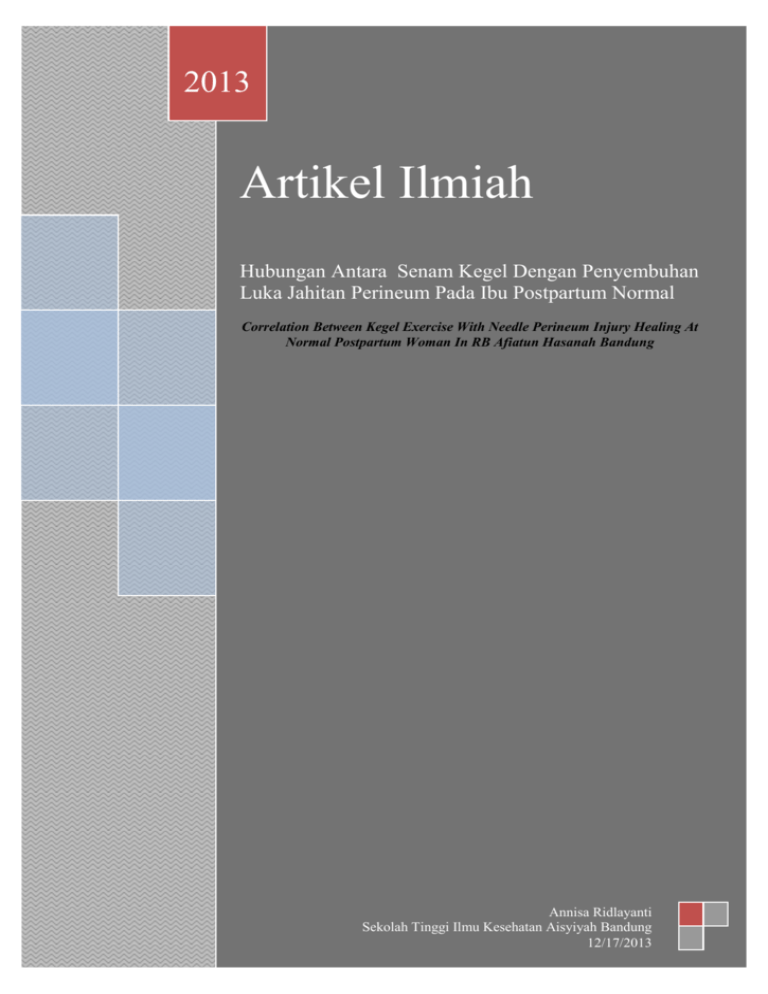
P 2013 Artikel Ilmiah Hubungan Antara Senam Kegel Dengan Penyembuhan Luka Jahitan Perineum Pada Ibu Postpartum Normal Correlation Between Kegel Exercise With Needle Perineum Injury Healing At Normal Postpartum Woman In RB Afiatun Hasanah Bandung Annisa Ridlayanti Sekolah Tinggi Ilmu Kesehatan Aisyiyah Bandung 12/17/2013 Correlation Between Kegel Exercise With Needle Perineum Injury Healing At Normal Postpartum Woman In RB Afiatun Hasanah Bandung Annisa Ridlayanti, STIKes Aisyiyah Bandung ABSTRACT Kegel exercise is a pelvic floor exercise which has a purpose to make strengthen pelvic muscle especially pubococcygeal muscle. In postpartum period, kegel exercise can help or speed up the perineum laceration injury healing. Recovery of needle perineum injury is influented by many factors, one of them is blood supply which contains O2 and nutrient to transfer for injury tissue. Contraction and relaxation which resulted by kegel exercise can increase blood supply to that injury tissue. Total of perineum hecting on postpartum woman in RB Afiatun Hasanah was 69,91% periode of January to June 2010. Based on medical record, about 43 from 79 patient (54,43%) still felt the pain of needle perineum injury and ‘felt’ not healing at own perineum injury in sixth days pospartum visit. This research purpose is to know there is correlation between kegel exercise and needle perineum injury healing in normal postpartum woman. And there is difference needle perineum injury healing in normal postpartum woman who doing kegel exercise and not doing kegel exercise. This riset analysis method uses desain of quasy experimental. Population contained 29 early normal postpartum woman (24 hours) during November 2010. Sample that was taked, early normal postpartum woman with needle perineum injury. For taking sample uses convinience sampling technique. The result, got 24 samples that’s divided into two groups. First groups was given kegel exercise and second groups wasn’t given kegel exercise. Independent variable is kegel exercise and dependent variable is needle perineum injury healing. To analyse data for correlation and comparison use Pearson and Mann Whitney test. The result from 24 sample on the 1st evaluation got 10 persons at the first groups and 4 persons at second groups who showed the normal perineum appearance. And on the 2nd evaluation at the first groups, all sample (12 persons) than at the second groups only 8 persons who showed normal perineum appearance. Pearson test result showed correlation as size as 0,742 with p value is 0,006 and p value < 0,05. This means there was correlation between kegel exercise and needle perineum injury healing. Comparison analisis test, based on statistic counting was gotten z Mann Whitney value -2,611 with P value is 0,020. Statistic test result showed that P value (0,020) < 0,05, so zero hipotesis was rejected. It could be concluted that there was difference needle perineum injury healing in normal postpartum woman who doing kegel exercise and not doing kegel exercise. Key words : kegel exercise, needle perineum injury healing, normal postpartum Introduction Method In Indonesia, no data about hecting of perineum after childbirth definitly. Wordpress (2010) shows that more than 85% pervaginam delivery with perineum lacerations. It can be spontaneoustly or episiotomi and 70%-80% in that case needs hecting of perineum. This riset purpose is to know there is correlation between kegel exercise with needle perineum injury healing in normal postpartum woman. And there is difference needle perineum injury healing in normal postpartum woman who doing kegel exercise and not doing kegel exercise. Total of perineum hecting on postpartum woman in RB Afiatun Hasanah was 69,91% periode of January to June 2010. Based on medical record, about 43 from 79 patient (54,43%) still felt the pain of needle perineum injury and ‘felt’ not healing at own perineum injury in sixth days pospartum visit. It shows that more than 50% patients after hecting perineum still feel uncomfort because of painful in sixth day postpartum period. Of course it needs perineum injury healing care optimally. Many factors which influent of tissue injury healing. One of them depends on cellular proliferations and syntetic activity because of sensitivity to deficiency local blood supply and patient’s nutrient condition.1,3,4,7 In normal delivery with perineum lacerations, tissue injury healing without infection usually needs 4-7 days for recovering.2,4,7 Kegel exercise can help perineum injury healing in postpartum with make a contraction and relaxation regulary at pubococcygeal muscle. It also can make perineum hecting become well and heal faster. Kegel exercise also can reduce the haemorroid and incontrinentia urine. It can reduce the painful by making the flexibility area. It is very simple and easy to do kegel exercise. It can do anywhere privatly in any positions like sit down, stand-up, and lying.3,17,18,30 This research method, analysis which use desain of quasy experimental. Population contained 29 early normal postpartum woman (24 hours) during November 2010. Sample that was taked, early normal postpartum woman with needle perineum injury. For taking sample uses non random sampling (convinience sampling) technique. Inclution criterias are postpartum normal, baby’s weight about 2500-4000 grams, getting perineum lacerations at least second degree or because of episiotomi, understanding the questions, patients can finish kegel exercise completly, there is an infomed consent. Exclution criterias are postpartum haemorrage when research is done and no informed consent or patient denial. The result, got 24 samples that’s divided into two groups. First groups was given kegel exercise and second groups wasn’t given kegel exercise. Independent variable is kegel exercise and dependent variable is needle perineum injury healing. To analyse data for correlation and comparison use Pearson and Mann Whitney test. Result This research is done from 1 November until 15 December 2010. Take place at “Rumah Bersalin Afiatun Hasanah Bandung”. In the first picture shows that kinds of perineum injury. There are laceration and episiotomi. Both of them are second degree perineum rupture. The first table shows about result of kegel exercise in the treatment group. More than 50% the subject do it completly. The second table tells about normal perineum appearance in twice examinations in 6th and 14th days. The third table is Output Pearson Correlations Analysis (SPSS). And the fourth table shows that there’s a difference perineum appearance between the first group (treatment kegel exercise) and second group (control). Picture.1 Subject Research Criteria From Kinds Of Perienum Injury 2nd Degree Laceration 8 3 Episiotomi 9 4 0 2nd Group Episiotomi 3 5 10 2nd Degree Laceration 9 Ist Group 4 8 Discussions Table.1 Result of Kegel Exercise in First Group Kegel Exercise Done completly Done partly Not Done Total Person 7 5 0 12 Based on table.3, Pearson correlation test shows that there’s a correlation between kegel exercise with needle perineum injury healing in normal postpartum. Percentage 58,33% 41,67% 0% 100% Table.2 Perineum Examinations In Normal Postpartum Normal Perineum Appear 6th Day 14th Day Tampilan Perineum Normal 1st Group 2nd Group 10 4 12 8 Table.3 Output SPSS Correlations Analysis Kegel Exercise Perineum Person Correlation 1 Kegel Exercise Sig.(2-tailed) N 12 Person Correlation Perineum Sig.(2-tailed) 12 N **. Correlation is significant at the 0.01 level (2-tailed) .742** .006 12 1 12 Table.4 Mann-Whitney Test Perineum lacerations Injury Healing Average Treatment 3.83 Kontrol 3.00 Z p value -2,611 0.020 Conclusion Ho Ditolak The result from 24 sample on the 1st evaluation got 10 persons at the first groups and 4 persons at second groups who showed the normal perineum appearance. And on the 2nd evaluation at the first groups, all sample (12 persons) than at the second groups only 8 persons who showed normal perineum appearance. Pearson test result showed correlation as size as 0,742 with p value is 0,006 and p value < 0,05. It means there was correlation between kegel exercise and needle perineum injury healing. Comparison analysis test, based on statistic counting was gotten z Mann Whitney value -2,611 with P value is 0,020. Statistic test result showed that P value (0,020) < 0,05, so zero hipotesis was rejected. It could be concluted that there was difference needle perineum injury healing in normal postpartum woman who doing kegel exercise and not doing kegel exercise. Ada perbedaan In the first evaluation, about 83,33% (10 from 12 person) in treatment group shows normal perineum appearance which needle close fastly, reduce the painful, no infection although signs of inflamations still be showed from some subjects but it is normal because inflamation process will be felt until 5-7 days. In the second evaluations, all subjects (12 person) shows normal perineum appearance. It is compatible that kegel exercise is not only prevent the incontinetia urine but also help the injury healing because of increasing blood supply to the tissue injury.1,12 So kegel exercise is a pelvic floor exercise which has a purpose to make strengthen pelvic muscle especially pubococcygeal muscle. In postpartum period, kegel exercise can help or speed up the perineum laceration injury healing by make the needle closed fastly and reduce the painful of perineum. Contraction and relaxation which resulted by kegel exercise can increase blood supply which contains the O2 and nutrient to injury tissue recovery.8,25,30,34 References 1. 2. Based on table 4, Z-Mann Whitney comparrison test shows that there’s a difference between needle perineum injury healing in normal postpartum who do kegel exercise and not do kegel exercise. Injury healing process to be seen from clinical perineum appearance. 3. Perineum appearance in the treatment group shows no opened-needle, no infection signs, no fistula rectovaginalis, and no long great painful at 10 subjects in the first evaluation. And 12 subjects (100%) show normal perineum appearance. It’s different with the control group which only 4 subjects in the first and 8 subjects (66,66%) in the second evaluation which show the normal perineum appearance. 8. 4. 5. 6. 7. 9. 10. 11. 12. 13. 14. Can be concluted that postpartum normal who do kegel exercise procedurally will get needle perineum injury healing fastly. 15. 16. From that research, every midwives can implementate kegel exercise when their’s patients get tears in perineum. Concelling and demonstrate how to do kegel exercice in postpartum period can be given by midwives. Make sure that patients do not be affraid with the hecting of perineum. It’s not dangerous, but it can help theirs perineum injury gets healing early and fastly. It also very easy, cheap, advantagable, and privatly. It is not need money to practice as we do an exercise daily. It also can reduce the medical treatment when the postpartum women get normal perineum injury. It is one of the core midwives competencies which giving a care to the physiologis client naturally not medicinally. 17. 18. 19. 20. 21. 22. 23. 24. 25. 26. 27. 28. 29. Boyle, Maureen. 2008. Pemulihan Luka : Seri Praktik Kebidanan. Jakarta : EGC. Herawati, P. (2010). “Hubungan Perawatan Perineum Dengan Kesembuhan Luka Perineum Pada Ibu Nifas Hari Keenam”. Surakarta : Fakultas Kedokteran. Universitas Sebelas Maret. Bahiyatun. 2009. Buku Ajar Asuhan Kebidanan Nifas Normal. Jakarta : EGC. Abraham S, Child A, Ferry J et al. (1990). Recovery after childbirth : a preliminary prospective study. Med J aust. 152 : 9-12. Brayshaw Eileen. 2007. Senam Hamil & Nifas : Pedoman Praktis Bidan. Jakarta : EGC. BØ K. 1995. Pelvic floor Muscle for the treatment of stress urinary incontinence : an exercise physiology perspective. International Urogynecology Journal 6 : 282-291. Coad, Jane. 2007. Anatomi Dan Fisiologi Untuk Bidan / Jane Coad, Melvyn Dunstall. Jakarta : EGC. Elia G dan Bregman A. (1993). Pelvic Muscle Exercise : When Do They Work ? Obstetr Gynaecol. 81 : 283-6. Errol R. Norwitz dan Jhon O. Schorge. 2008. At a Glance Obstetri Dan Ginekologi. Jakarta : Penerbit Erlangga/ PT. Gelora Aksara Pratama. Fathoni, Abdurrahmat. 2006. Metodologi Penelitian Dan Teknik Penyusunan Skripsi. Jakarta : PT Rineka Cipta. Fleeming V, Hagen S dan Niven C (2003). Does Perineal Suturing Make A Difference ? The SUNS Trial. Br J Obstet Gynaecol. 110 : 684-9. Glazener C, Herbison G, Wilson P et al. (2001). Conservative Management Of Persistent Postnatal Urinary And Faecal Incontinence : A Randomised Controlled Trial. BMJ. 323 : 593-6. Hay-Smith E. J. Bo Berghams L. C, Hendrics H. J. Et al (2001). Pelvic floor muscle training for urinary incontinence in women. Cochrane Database Systemic Revue (1) : CD001407. Head M (1993). Non-Suturing Of Tears To The Perineum. In : Proceedings of the International Confederation of Midwifery, 23rd International Congress, Vancouver, Canada : 809-22. 9-14 May 1993. Hidayat, Aziz Alimul. 2007. Metode Penelitian Kebidanan Dan Teknik Analisis Data. Jakarta : Salemba Medika. Indiarti, M.T. 2008. Senam Hamil & Balita. Yogyakarta. Cemerlang Publishing. International Continence Society (2002). The Standardisation of Terminology in Lower Urinary Tract Function : Report From The Standardisation Sub-committee of the International Continence Society. Jolley J. V. 1990. The reported prevalence of urinary symptoms in women in one rural practice. British Journal Of General Practice 40 : 335-337. Jones, D Llewellyn. 2001. Dasar-Dasar Obstetri Dan Ginekologi Ed. 6. Jakarta : Hipokrates, pp 56-79. Kumala, Poppy et.al. 2005. Kamus Saku Kedokteran Dorland Ed. 25. Jakarta : EGC. Lewis G (ed.) (2004). Why Mothers Die : Confidental Enquiries Into Maternal Deaths In The UK : 2000-2002. RCOG Press, London. Maryunani, Anik. 2009. Asuhan Pada Ibu Dalam Masa Nifas (POSTPARTUM). Jakarta : CV. Trans Info Media. Morgan, Geri dan Carole Hamilton. 2009. Obstetri & Ginekologi : Panduan Praktik / geri Morgan, Carole Hamilton Ed. 2. Jakarta : EGC. 2009. Morkved S, Bo K, 1997. The effect of postpartum pelvic floor exercise in the prevention and treatment of urinary incontinence. International Urogynecology Journal 8 : 217-222. Morkved S, Bo K, 2000. Effect of postpartum pelvic floor muscle training in prevention and treatment of urinary incontinence : a oneyear follow up. British Journal Of Obstetrics & Gynaecology 107 : 1022-1028. Murkhoff, et.al. 2007. Mengatasi Trauma Pascapersalinan. Jawa Tengah. Image Press. Nursalam. (2008). Konsep Dan Penerapan Metodologi Penelitian Ilmu Keperawatan Ed.2 Pedoman Skripsi, Tesis, dan Instrumen Penelitian Keperawatan. Jakarta : Salemba Medika. Prawirohardjo, Sarwono. 2009. Ilmu Kebidanan. Jakarta : YBPSP. Saifuddin, Abdul Bari, dkk. 2004. Buku Panduan Praktis Pelayanan Kesehatan Maternal Dan Neonatal Ed.1. Jakarta : Yayasan Bina Pustaka Sarwono Prawirohardjo. Simkin Penny, Janet Whalley, Ann Keppler. 2007. Kehamilan, Melahirkan, & Bayi : Panduan Lengkap. Jakarta : Arcan. 30. Sleep, J Dan Grant A. (1987). Pelvic Floor Exercise In Postnatal Care. Midwifery 3 : 158-64. 31. Sudjatmiko, Gentut. 2009. Menjahit Luka. Jakarta : CV Sagung Seto. 32. Sugiono. 2007. Statistika Untuk Penelitian. Bandung : CV Alfabeta. 33. Suyanto dan Ummi Salamah. 2008. Riset Kebidanan. Jogjakarta : Mitra Cendikia Press. 34. Taskin, Omur, dkk. (1996). The Effects Of Episiotomy And Kegel Exercises On Postpartum Pelvic Relaxation : A Prospective Controlled Study. Journal Of Gynecologic Surgery. Summer, 12 (2) : 123-127. 35. Thakar R, Stanton S. 2002. Management of genital prolapse. British Medical Journal 324 (7348) : 1258-1262.
